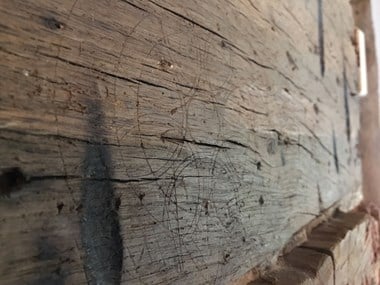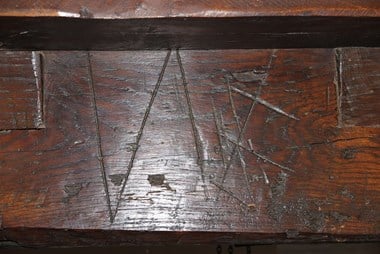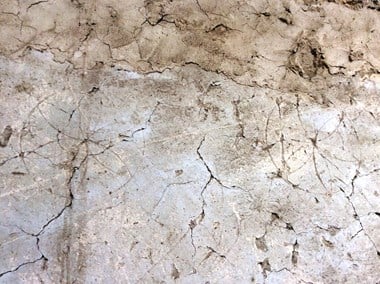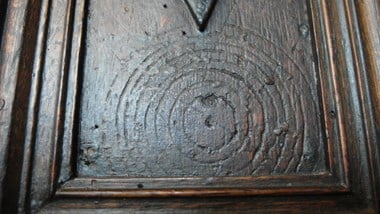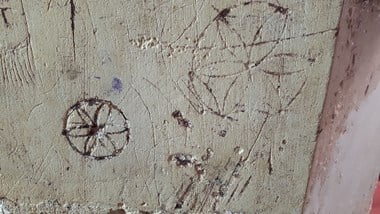Sign up to our newsletter to discover Historic England's work and find out about news and projects near you.
A Look at What We Found Out From the Public
The appeal for information produced over 600 responses from the public and we were grateful for every one we received.
Over 100 of these were from different countries, namely Scotland and Wales. Although outside the scope of these pages, these demonstrate that the practice of using ritual protection symbols was spread across the British Isles.
Many were accompanied by photographs, some instead by a detailed description. Receiving these responses was fascinating as there was an intriguing range of markings to be seen.
Some did not appear to be apotropaic markings, but rather decorations of a similar pattern adorning furniture, or historic graffiti, which is of great interest itself.
Markings shared with us
- East Midlands, 31
- East of England, 150
- South East, 104
- South West, 114
- West Midlands, 51
- Yorkshire, 17
- North West, 29
- London, 11
These statistics are to some extent a recognition of the density of listed buildings, but Yorkshire and London are seriously under-represented whilst East of England is possibly over represented.
The result from London is unsurprising considering the general age of buildings in the capital. The high number of responses from the East of England must be a reflection of the great deal of research into ritual deposits and markings in this region. There is no ready explanation for the lack of Yorkshire examples.
The most common mark recorded is the hexafoil, or daisy wheel, which range from the straightforward singletons to complex interlinked multiple examples. According to the public’s responses, they occur across the whole of England and on a variety of buildings from the medieval to the 19th century, including in houses, farm buildings and churches. It is of course impossible to be certain of the date of the marks but there are certainly much later examples, on 19th century buildings, than expected.
As for locations, they occur on ceilings and walls (none recorded on floors) and with some preference for being near openings, most commonly above mantel pieces, but also close to doors and windows.
The following is an overview of the areas which yielded the richest and most varied responses from the public.
Snapshot of the South East
In the South East we received 104 responses with information. The most common type of marking recorded were hexafoils, or daisy wheels, with six scribed onto timber, three onto stone and one onto plaster.
The timber examples are particularly interesting in that they offer the best potential for dating. One beautiful example on a ceiling beam was clearly scribed onto the timber whilst it was still green, or fresh. As the timber aged it dried out and developed cracks which slightly distorted the design. This suggests the mark was made when the timber was new, perhaps during the construction of the building.
In another example, it seemed the design was added some time after the timber dried out, which poses interesting questions about why these markings were made at different times and what they really meant to the people making them.
Other markings, besides hexafoils, were also reported in the South East. There were eight examples of circles being scribed into the fabric of buildings, some depicting a design of many intersecting circles, others being just a simple circle. They were all found on either timber or stone.
Also found were:
- An M, thought to stand for Mary
- Two taper burn marks
- Six carpenters’ numbers
- Two levelling marks
- One organised grid
- Four graffiti
- One shipping mark
- One merchants’ mark
Some marks have even been found on furniture. The most interesting example of this from the South East was perhaps a daisy wheel inside a long case clock, which belongs to a family who also found a number of taper burn marks inside furniture.
One other mark reported was a scratch dial on the stonework of a church. And finally one mark, actually found on a building in Guernsey, was unique among all the responses as it looked like a pair of spectacles!
Snapshot of the West Midlands
We received 51 responses from people in the West Midlands. Again, the most common type recorded in this region were hexafoils, with four examples found on timber, three on stone and one on a brick building dated to the 1730s.
However, designs with circles were found in this region too, with two examples of simple circles, two of concentric circles, one intersecting and two daisy wheels formed from intersecting circles. The simple circles included a set painted on a hearth stone, which is the perpetuation of a tradition established at the Fleece in Bretforton (owned by the National Trust) which are renewed from time to time.
Again, a variety of marks were found scribed into timber in this region:
- Two sets of Marian marks and two on stone
- One taper burn mark
- Two carpenters’ numbers
- Three levelling marks
- Three graffiti (plus one on stone)
- One shipping mark
- One merchants mark (plus one on stone)
Snapshot of the South West
The South West was another productive region, with 114 responses from the public.
The most common type were daisy wheels again, with six examples on timber, five on stone and one on plaster. There were also two daisy wheels formed from intersecting circles on timber.
A type not seen elsewhere was a 12 petal daisy wheel, of which there were two on timber. And we also received three of examples of interlinked arcs and circles forming more complicated geometric shapes, found on both stone and timber.
Timber appeared to be the material where most marks were found:
- Seven taper burn marks
- Five Marian marks
- Four carpenters’ numbers
- One levelling mark
- Four graffiti
- One merchants mark
- Two sets of random marks
- Seven taper burn marks
Snapshot of the East of England
We had a number of responses from the East of England. They included a variety of markings, from taper burns, Marian markings and series of letters on timber, to hexafoils scribed onto furniture, plaster wall panels and brick.
Perhaps the most intriguing array of markings were found on timber, some of which are inarguably apotropaic in form and others are seemingly graffiti.
A rather beautiful design of interlocking circles, found on an inglenook fireplace, can be seen in one example right next to the distinctive shape of a taper burn.
It is markings such as this which have surely led to some seeing hexafoils, and larger designs of many hexafoils, as geometric exercises for apprentices.
Gallery of highlights from other regions
Please click on the gallery images to enlarge.
Get involved
Share your images of witches' marks on social media (#WitchesMarks) or, if found in a listed building, why not add to the Missing Pieces Project.
-
Discovering Witches’ Marks
A brief history of various types of markings and highlighting some of the responses from the public after our call out for information.
-
What are witches’ marks?
Ritual protection symbols or apotropaic marks found in many historic places, from medieval churches and houses, to barns, and caves to protect inhabitants and visitors from witches and evil spirits.
-
How are these markings created?
Discover the methods used to create witches' marks.
-
Apotropaic and Carpenters’ Marks
What distinguishes carpenters’ marks from apotropaic marks.


